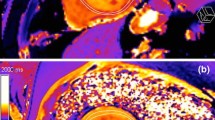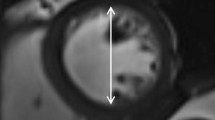Abstract
Myocardial edema and inflammation play an important role in dilated cardiomyopathy (DCM). This pathologic condition can be identified noninvasively using cardiovascular magnetic resonance imaging (CMR). The purpose of this study was to determine the effectiveness of T2 values obtained with T2 mapping in the detection of edema in DCM patients, compared with that of conventional T2-weighted imaging (T2WI). CMR was used for 15 normal controls (NML) and 26 DCM patients. The DCM patients were classified as having either mild dysfunction with a left ventricular ejection fraction (EF) >35 % or severe dysfunction with an EF ≤35 %. Myocardial edema was assessed by both T2 mapping and T2WI. The differences between the T2 values determined from T2 mapping and the T2 ratios that were calculated from the T2WI were compared among the NML, mild DCM, and severe DCM patients. The T2 values for the NML, mild DCM, and severe DCM patients were 51.2 ± 1.6, 61.2 ± 0.37, and 67.4 ± 6.8, respectively (P < 0.05 for each pair), and the corresponding T2 ratios were 1.88 ± 0.09, 2.12 ± 0.37, and 2.04 ± 0.34, respectively (P > 0.05). T2 mapping clearly showed that the myocardial water content was larger in DCM patients than in NML controls and that the myocardial water content increased as the disease progressed. Thus, T2 mapping is a useful technique for the diagnosis and quantitation of diffuse myocardial edema.




Similar content being viewed by others
References
Luk A, Ahn E, Soor GS et al (2009) Dilated cardiomyopathy: a review. J Clin Pathol 62(3):219–225
Jefferies JL, Towbin JA (2010) Dilated cardiomyopathy. Lancet 375(9716):752–762
Piran S, Liu P, Morales A et al (2012) Where genome meets phenome: rationale for integrating genetic and protein biomarkers in the diagnosis and management of dilated cardiomyopathy and heart failure. J Am Coll Cardiol 60(4):283–289
McCrohon JA, Moon JC, Prasad SK et al (2003) Differentiation of heart failure related to dilated cardiomyopathy and coronary artery disease using gadolinium-enhanced cardiovascular magnetic resonance. Circulation 108(1):54–59
Assomull RG, Prasad SK, Lyne J et al (2006) Cardiovascular magnetic resonance, fibrosis, and prognosis in dilated cardiomyopathy. J Am Coll Cardiol 48(10):1977–1985
Wu KC, Weiss RG, Thiemann DR et al (2008) Late gadolinium enhancement by cardiovascular magnetic resonance heralds an adverse prognosis in nonischemic cardiomyopathy. J Am Coll Cardiol 51(25):2414–2421
Kono AK, Ishii K, Kumagai H et al (2010) Late gadolinium enhancement on cardiac magnetic resonance imaging: is it associated with a higher incidence of nonsustained ventricular tachycardia in patients with idiopathic dilated cardiomyopathy? Jpn J Radiol 28(5):355–361
Ismail TF, Prasad SK, Pennell DJ (2012) Prognostic importance of late gadolinium enhancement cardiovascular magnetic resonance in cardiomyopathy. Heart 98(6):438–442
Higgins CB, Herfkens R, Lipton MJ et al (1983) Nuclear magnetic resonance imaging of acute myocardial infarction in dogs: alterations in magnetic relaxation times. Am J Cardiol 52(1):184–188
Abdel-Aty H, Zagrosek A, Schulz-Menger J et al (2004) Delayed enhancement and T2-weighted cardiovascular magnetic resonance imaging differentiate acute from chronic myocardial infarction. Circulation 109(20):2411–2416
Friedrich MG, Abdel-Aty H, Taylor A et al (2008) The salvaged area at risk in reperfused acute myocardial infarction as visualized by cardiovascular magnetic resonance. J Am Coll Cardiol 51(16):1581–1587
Friedrich MG, Sechtem U, Schulz-Menger J et al (2009) Cardiovascular magnetic resonance in myocarditis: a JACC White Paper. J Am Coll Cardiol 53(17):1475–1487
Butler CR, Thompson R, Haykowsky M et al (2009) Cardiovascular magnetic resonance in the diagnosis of acute heart transplant rejection: a review. J Cardiovasc Magn Reson 11:7
Jeserich M, Foll D, Olschewski M et al (2012) Evidence of myocardial edema in patients with nonischemic dilated cardiomyopathy. Clin Cardiol 35(6):371–376
Kuhl U, Noutsias M, Seeberg B et al (1996) Immunohistological evidence for a chronic intramyocardial inflammatory process in dilated cardiomyopathy. Heart 75(3):295–300
Giri S, Chung YC, Merchant A et al (2009) T2 quantification for improved detection of myocardial edema. J Cardiovasc Magn Reson 11:56
Elliott P (2000) Cardiomyopathy. Diagnosis and management of dilated cardiomyopathy. Heart 84(1):106–112
Kramer CM, Barkhausen J, Flamm SD et al (2008) Standardized cardiovascular magnetic resonance imaging (CMR) protocols, society for cardiovascular magnetic resonance: board of trustees task force on standardized protocols. J Cardiovasc Magn Reson 10:35
Cerqueira MD, Weissman NJ, Dilsizian V et al (2002) Standardized myocardial segmentation and nomenclature for tomographic imaging of the heart. A statement for healthcare professionals from the Cardiac Imaging Committee of the Council on Clinical Cardiology of the American Heart Association. Circulation 105(4):539–542
Mahrholdt H, Goedecke C, Wagner A et al (2004) Cardiovascular magnetic resonance assessment of human myocarditis: a comparison to histology and molecular pathology. Circulation 109(10):1250–1258
Foltz WD, Al-Kwifi O, Sussman MS et al (2003) Optimized spiral imaging for measurement of myocardial T2 relaxation. Magn Reson Med 49(6):1089–1097
Huang TY, Liu YJ, Stemmer A et al (2007) T2 measurement of the human myocardium using a T2-prepared transient-state TrueFISP sequence. Magn Reson Med 57(5):960–966
Blume U, Lockie T, Stehning C et al (2009) Interleaved T(1) and T(2) relaxation time mapping for cardiac applications. J Magn Reson Imaging 29(2):480–487
Sparrow P, Amirabadi A, Sussman MS et al (2009) Quantitative assessment of myocardial T2 relaxation times in cardiac amyloidosis. J Magn Reson Imaging 30(5):942–946
Verhaert D, Thavendiranathan P, Giri S et al (2011) Direct T2 quantification of myocardial edema in acute ischemic injury. JACC Cardiovasc Imaging 4(3):269–278
Abdel-Aty H, Siegle N, Natusch A et al (2008) Myocardial tissue characterization in systemic lupus erythematosus: value of a comprehensive cardiovascular magnetic resonance approach. Lupus 17(6):561–567
Stensaeth KH, Hoffmann P, Fossum E et al (2012) Cardiac magnetic resonance visualizes acute and chronic myocardial injuries in myocarditis. Int J Cardiovasc Imaging 28(2):327–335
Thavendiranathan P, Walls M, Giri S et al (2012) Improved detection of myocardial involvement in acute inflammatory cardiomyopathies using T2 mapping. Circ Cardiovasc Imaging 5(1):102–110
Ferreira VM, Piechnik SK, Dall’Armellina E et al (2012) Non-contrast T1-mapping detects acute myocardial edema with high diagnostic accuracy: a comparison to T2-weighted cardiovascular magnetic resonance. J Cardiovasc Magn Reson 14:42
Wassmuth R, Abdel-Aty H, Bohl S et al (2011) Prognostic impact of T2-weighted CMR imaging for cardiac amyloidosis. Eur Radiol 21(8):1643–1650
He T, Gulati A, Jabbour A, Ismail TF, Feng Y, Ismail N, Gonçalves C, Brown T, Firmin DN, Prasad SK, Pennell DJ (2012) Cardiovascular magnetic resonance T2 mapping detects myocardial edema in patients with chronic dilated cardiomyopathy. J Cardiovasc Magn Reson 14(Suppl 1):O29. http://www.jcmr-online.com/content/14/S1/O29. Cited 26 Jan 2014
Kellman P, Aletras AH, Mancini C et al (2007) T2-prepared SSFP improves diagnostic confidence in edema imaging in acute myocardial infarction compared to turbo spin echo. Magn Reson Med 57(5):891–897
Simonetti OP, Finn JP, White RD et al (1996) “Black blood” T2-weighted inversion-recovery MR imaging of the heart. Radiology 199(1):49–57
Messroghli DR, Radjenovic A, Kozerke S et al (2004) Modified Look-Locker inversion recovery (MOLLI) for high-resolution T1 mapping of the heart. Magn Reson Med 52(1):141–146
Messroghli DR, Plein S, Higgins DM et al (2006) Human myocardium: single-breath-hold MR T1 mapping with high spatial resolution–reproducibility study. Radiology 238(3):1004–1012
Conflict of interest
The authors have no conflict of interest to declare.
Author information
Authors and Affiliations
Corresponding author
Rights and permissions
About this article
Cite this article
Nishii, T., Kono, A.K., Shigeru, M. et al. Cardiovascular magnetic resonance T2 mapping can detect myocardial edema in idiopathic dilated cardiomyopathy. Int J Cardiovasc Imaging 30 (Suppl 1), 65–72 (2014). https://doi.org/10.1007/s10554-014-0414-z
Received:
Accepted:
Published:
Issue Date:
DOI: https://doi.org/10.1007/s10554-014-0414-z




